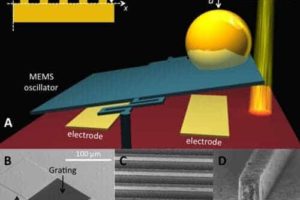casimir effect
Relativistic interpertation of Casimir effect where longer fluctuations only appear shorter due to time dilation
An unusually exotic theory of sonoluminescence, which received much popular attention, is the Casimir energy theory suggested by noted physicist Julian Schwinger which focuses on long distance quantum radiative phenomenon associated not with atoms, but with fast-moving surfaces in the collapsing bubble.
Experiment could reveal ‘extra dimensions,’ exotic forces
Physicists have devised a new experiment that will be used in the quest for exotic forces in nature and “additional spatial dimensions.” The researchers have shown what they say is a new way to measure a phenomenon known as the Casimir effect ? findings that also could have implications for the design of microscopic machines that contain tiny parts on the size scale of nanometers ? or billionths of a meter. The Casimir effect, predicted in 1948 by Dutch physicist Hendrick Casimir, is a force that pushes together two plates of metal placed near each other in empty space ? or a vacuum. The closer the plates are to each other, the stronger the force.


